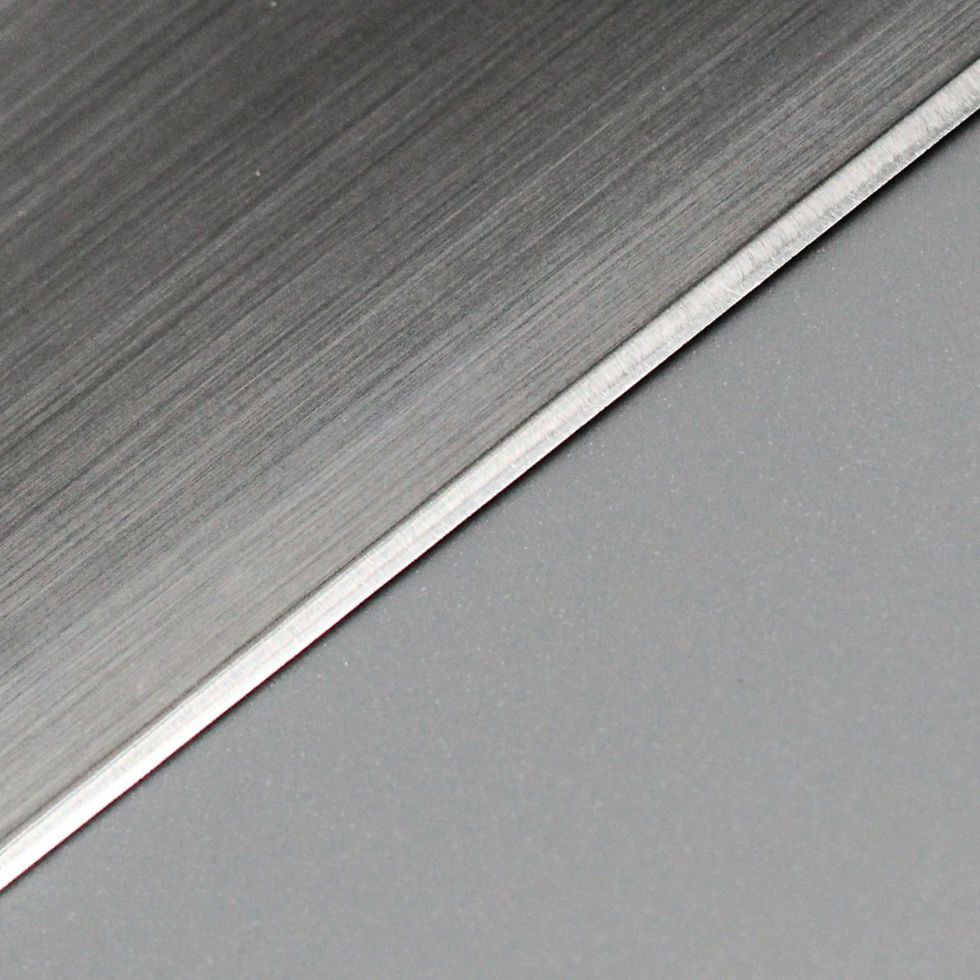Knife Steel Properties - How The Properties Of Steel Affect Your Knife
- Keith Nix

- Jan 14, 2024
- 5 min read
Updated: Feb 23, 2024
These are the properties of knife steels that matter most to knife owners and makers.

Some Custom knife makers use a dozen different steel alloys to make knives, others only one. Their choice will affect your custom knife for its entire life. So you either trust your knifemaker or question WHY they only use "Steel A" for the knives they make. It's important enough to know that you should ask.
The properties of a given knife steel affect how a user or owner of that knife perceives the usability of that given knife. Does it stay sharp for a reasonable time? Does it chip or deform when used? Does it rust when left wet?
Check the list of Knife Steel Properties below that control these "usability" features and make your new knife easy to use and maintain!
1 - Knife Steel Hardness
Steel hardness is a measure of the strength of your knife or its ability to resist permanent deformation. Most often, knife steels are tested for hardness using the Rockwell C scale. The Rockwell tester works by indenting steel with a fixed load and then measuring the distance the indenter penetrates the steel. This reading then gives the knife maker a quality assurance measurement to be sure the heat treatment protocol for a given knife has been successful. High hardness increases edge retention and reduces toughness, so a "tempering" process is applied after the initial heat treatment to reduce brittleness while maintaining an appropriate hardness for the intended use of the knife.
In the past, Rockwell readings of 52-57 were considered adequate for most knives. Many newer steels and even older formulations easily achieve Rockwell 62-65 while maintaining adequate toughness. This alone improves edge retention.
2 - Steel Toughness
The toughness of given steel tells us the steel's ability to resist breakage, chipping, fracture, or catastrophic failure. It is typically measured with a Charpy Impact tester. This is a destructive test where a weighted pendulum is dropped into a steel sample of a controlled size. The amount of force required to break the sample is recorded at foot-pounds of torque. The higher the force required to break the sample, the higher the toughness. Tougher steel displays greater resistance against impact, bending, and twisting forces. It can also take a finer edge without the risk of microfractures, to a reasonable extent.
One of the Catch-22 scenarios in knife making is this - as hardness increases, toughness decreases. So, it becomes important for the knife maker to find a balance between the two properties that make for a useable knife.
"Toughness is a measure of how much resistance a steel has to fracturing. In the context of a knife, this would be chipped edges or broken knives." -Dr Larrin Thomas, Knife Steel Nerds
3 - Edge Retention
The quantity and hardness of carbides in the hardened matrix of a steel knife are crucial in determining its wear resistance and edge retention. The iron/carbon phase known as martensite has a maximum theoretical hardness based on carbon content, but it has a limited useable hardness before it becomes too brittle for practical use.
Carbides, which are formed when alloying elements are added to the original steel, play a significant role in increasing edge retention and wear resistance. Most alloying elements can join with carbon to create carbides that are considerably harder than the surrounding steel matrix. Chromium carbides, even though they are the softest, are significantly harder than the steel matrix holding them in place. The hardest carbides are Vanadium and Niobium carbides.
However, there is a tradeoff with carbides, as with all things knife and steel-related. Carbides in significant volume, especially in large sizes, can make any steel less tough by creating crack initiation points that weaken the steel. Machinists often use carbide cutting tools that are very hard but also very brittle. Therefore, some carbide in knives is good, but not too much.
Edge retention refers to the ability of a knife to retain its edge during cutting. Factors controlling edge retention are hardness, toughness, carbide content of the steel, and the edge geometry of the knife. For example, a harder knife will cut longer than a softer knife of a given steel. Tougher steel will resist chipping and micro-fractures that would compromise the edge at the microscopic level. Steels with a higher carbide content typically have better edge retention simply because carbides are harder than the steel matrix surrounding them. Below is a hardness chart of typical carbides that could be present in a given knife steel, provided the element is in the steel. The far right column shows Rockwell C hardness for each. The increased hardness of the carbides provides additional edge retention.

Dr Larrin Thomas has done extensive testing around edge retention. His results and analysis are in this article: "Testing The Edge Retention of 48 Knife Steels"
4 - Stain Resistance
Stain resistance most often refers to a knife's ability to resist corrosion and oxidation or, more simply, rust. To make a steel stainless, enough Chromium must be added at the foundry so there is "free Chromium" in the matrix that isn't tied up with carbon in carbides. This free Chromium then reacts with Oxygen on the surface of your knife to create a microscopic layer of Chromium Oxide. It is this layer that provides the steel of your knife with stain resistance. Molybdenum and some other elements also contribute to stain resistance.
5 - Sharpenability
The term "sharpenability" refers to the ease or difficulty of achieving a proper edge on a knife made from a particular type of steel. This aspect is affected by wear resistance, as sharpening involves removing any material that doesn't contribute to a precise edge. If a knife steel is highly wear-resistant and contains a large amount of hard carbides, it may be difficult to sharpen without the use of diamond stones. On the other hand, simple carbon steels can be sharpened easily but may not have a long edge retention.
Knife Steel Properties Matter For The Life Of Your Knife
No single steel is perfect for EVERY job a knife might do. Simple carbon steels are easily sharpened and take a keen edge, but without your dedication to proper maintenance, they will turn orange with rust. Knives with extreme edge retention are notoriously difficult to sharpen for you and very difficult for me to make a knife from.
Let's have a talk about how you intend to use your knife, your attention to maintenance, your ability to sharpen, and other factors. Then we can choose a knife steel that's right for you!
More FREE Learning:
Order Your Custom Knife from Keith Nix Knives Shop Now!
828-337-7836
Thanks for reading,
Keith




Comments